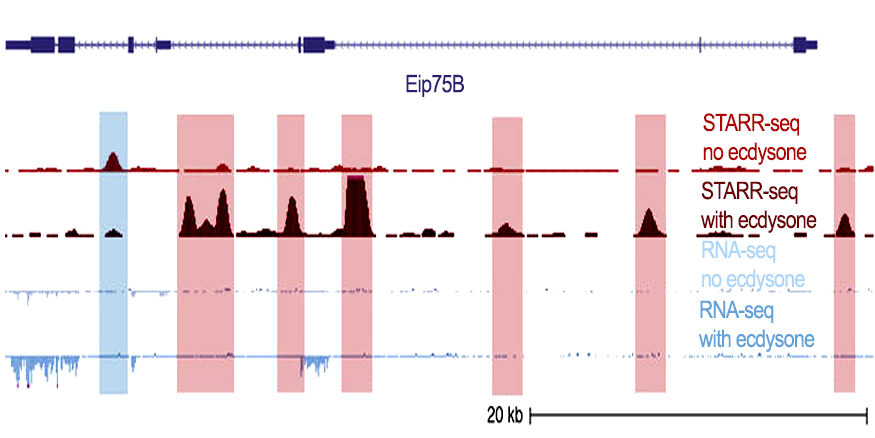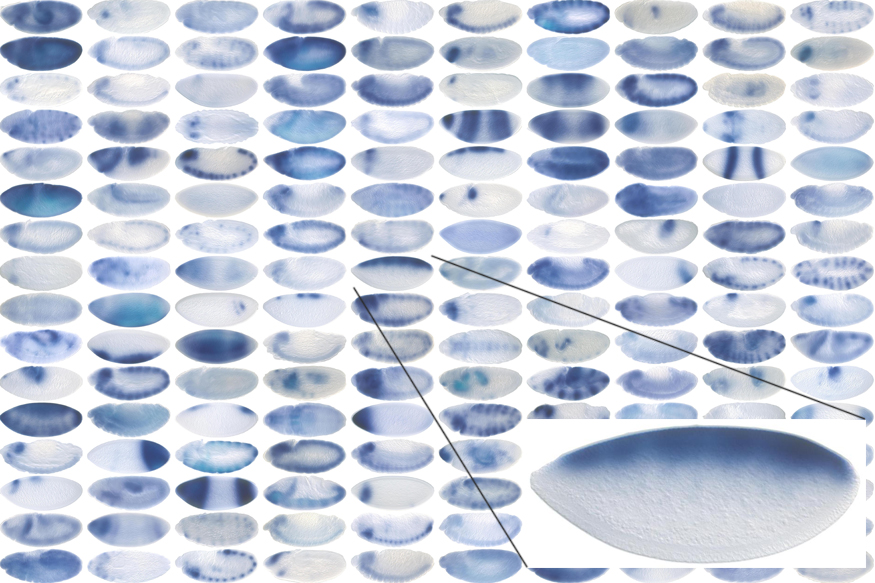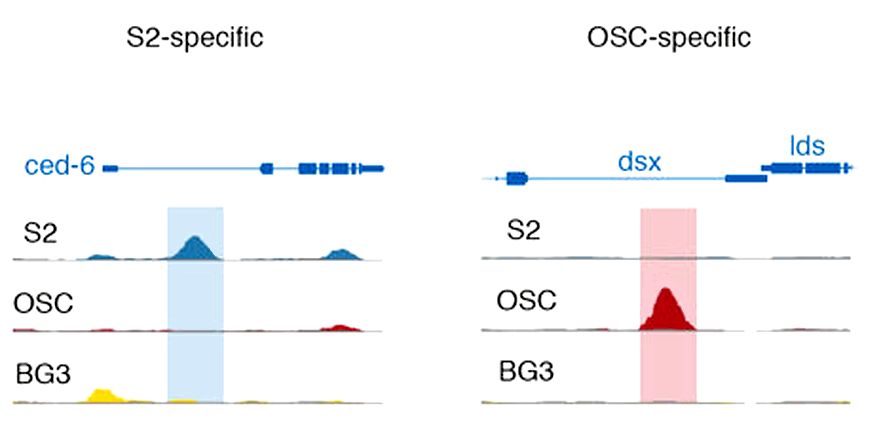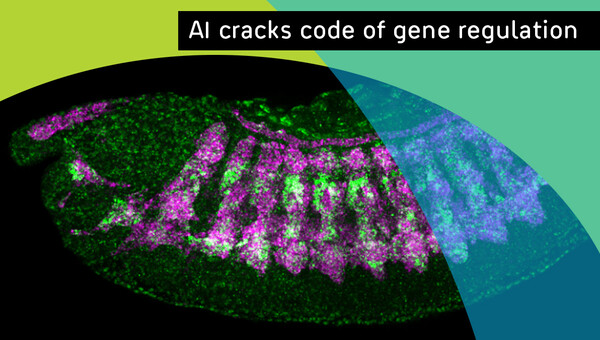Understanding transcriptional regulation
Transcription – the copying of genomic DNA into RNA – is one of the most fascinating processes in biology, particularly in animals in which different cell types transcribe different genes to acquire different morphologies and functions. This differential gene transcription is a prerequisite of multi-cellularity, the main driver of animal development, and underlies most of the differences we observe between closely related species; failures in this tightly regulated process are causal to many diseases including cancer.
To us, the discrepancy between the seeming simplicity of transcriptional regulation and the apparent difficulty of obtaining mechanistic insights to a satisfying level is particularly fascinating: enhancer sequences, typically drive gene expression patterns reliably in both their endogenous genomic contexts and in simple reporter systems. However, despite this defined sequence-to-function relationship, the exact sequence requirements for enhancer activity remain unknown. Similarly, how combinations of transcription factor and cofactor proteins control enhancer function and mediate the transcriptional activation of target core-promoters has remained elusive.
Our aim is to understand how transcription is regulated at the level of the two key types of regulatory genomic elements – enhancers and core-promoters – and the transcription factor and cofactor proteins that mediate transcription activation. To reach this goal, we follow an interdisciplinary approach, using genome-wide functional assays, bioinformatics, biochemistry, and mass-spectrometry. We develop and employ highly-controllable reporter assays that provide reliable functional readouts for each of questions we ask, while circumventing the many confounding issues that exist in complex gene regulatory systems in vivo.
Genome-wide quantitative enhancer activity maps
We have developed STARR–seq (self-transcribing-active-regulatory-region-sequencing), a massively parallel enhancer activity assay based on next-generation sequencing. STARR-seq allows for the identification of transcriptional enhancers in a direct and quantitative manner in entire genomes, drawing genome-wide quantitative enhancer activity maps. We are applying STARR-seq in Drosophila and human cells to understand the sequence basis of cell-type specific enhancer activities.

Genome-scale enhancer characterization in Drosophila embryos

We have determined the temporal and spatial enhancer activity in Drosophila embryos of 7793 transcriptional reporter constructs integrated at a single defined genomic position in transgenic lines (Vienna-Tiles [VT] library). This provides the first genome-scale view on how developmental gene regulation is organized in an animal’s genome and how regulatory DNA sequences encode different patterns of gene expression.
All the data is available from http://enhancers.starklab.org.
Genome-wide assessment of enhancer responsiveness
We have developed STAP-seq (Self-Transcribing Active core-Promoter-sequencing) to measure the enhancer responsiveness of core-promoter candidates genome-wide. While STARR-seq assesses enhancer function using a constant core-promoter, STAP-seq quantifies the ability of core-promoter candidates to initiate transcription provided activating input from a defined constant enhancer. STAP-seq thereby enables the identification of transcription initiation sites (TSSs) and the quantification of how strongly each TSS activates transcription in response to enhancers, i.e. the TSS’s enhancer responsiveness.
Direct identification of regulatory activities of transcription factors and cofactors
We have developed an enhancer complementation assay that allows for the testing of regulatory activities of transcription factors and cofactors regardless of their endogenous DNA binding specificities and developmental roles. By tethering these factors to different sites in mutant enhancers, we are able to quantify their regulatory activities in different contexts. Our results on the function of 474 Drosophila transcription factors and 338 transcriptional cofactors are available from http://factors.starklab.org.
Cracking the transcriptional regulatory code
We use bioinformatics and machine-learning to dissect regulatory sequences and determine sequence features (e.g. TF motifs) that are predictive of regulatory function and required for enhancer activity. Our goal is to: achieve a systematic understanding of the structure and functions of enhancers, i.e. to “crack” the regulatory code; predict enhancer activity from the DNA sequence; and understand how transcriptional networks define cellular and developmental programs.

Comparative genomics – tracing sequences through evolution
Functional elements in a genome are often under evolutionary selection to maintain their functions in related organisms. We study the conservation and divergence of TF binding and enhancer activity and the underlying regulatory DNA sequences across different Drosophila species. Conservation and divergence allow for powerful insights into how gene regulation is encoded in the DNA sequence and how it changes during evolution.
Determining and understanding tissue-specific TF binding
Determining and understanding tissue-specific TF binding
Transcription factors are employed at developmental stages and in different tissues and typically bind to and regulate different targets in each context. We use tissue-specific ChIP-Seq to determine context-specific TF binding and study its sequence determinants, focusing on embryonic mesoderm and muscle development, the circadian clock, and homeobox (Hox) transcription factors.
Selected Publications
- De Almeida, BP., Schaub, C., Pagani, M., Secchia, S., Furlong, EEM., Stark, A. Targeted design of synthetic enhancers for selected tissues in the Drosophila embryo. Nature 2024. 626, 207–211. DOI: 10.1038/s41586-023-06905-9
- Neumayr C.*, Haberle V.*, Serebreni L., Karner K., Hendy O., Boija A., Henninger J.E., Li C.H., Stejskal K., Lin G., Bergauer K., Pagani M., Rath M., Mechtler K., Arnold C.D., Stark A. Differential cofactor dependencies define distinct types of human enhancers. Nature, 2022. 606, 406–413
- De Almeida BP, Reiter F, Pagani M, Stark A. DeepSTARR predicts enhancer activity from DNA sequence and enables the de novo design of synthetic enhancers. Nature Genetics, 2022. 54, 613–624.
- Haberle, V., Arnold, CD., Pagani, M., Rath, M., Schernhuber, K., Stark, A. (2019)
Transcriptional cofactors display specificity for distinct types of core promoters.
Nature. 570(7759):122-126. - Arnold, CD., Gerlach, D., Stelzer, C., Boryń, ŁM., Rath, M., Stark, A. (2013). Genome-wide quantitative enhancer activity maps identified by STARR-seq. Science. 339(6123):1074-7
Join us
- Master students and Post-docs: Contact Alexander Stark with a letter of intent detailing why you want to join the lab.
- PhD students: Calls open 1 March and 1 September, apply here:
Vienna BioCenter PhD Program



